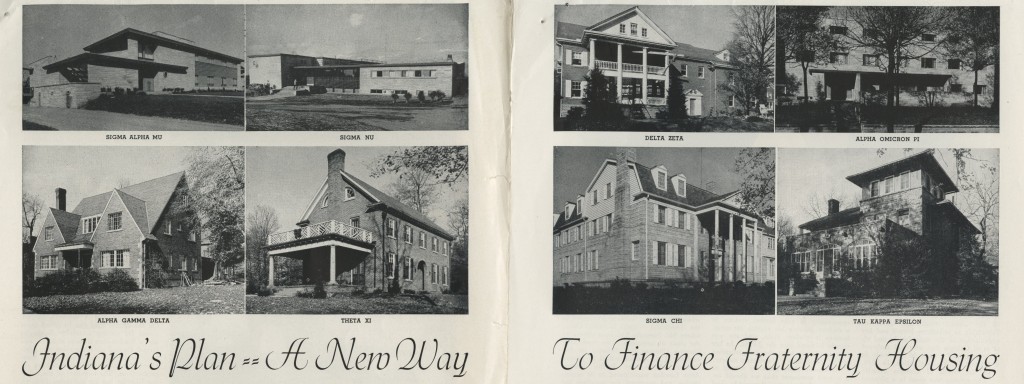There has been a good deal of coverage in the local papers and social media sites over the last few months about IU property on East 8th Street in the University Courts neighborhood and the potential demolition of the current properties to make way for a new Phi Gamma Delta (Fiji) house. I decided to do a little research on the more recent (in the archival world, this is relative – I’m talking the latter half of the 20th century) history of housing of IU Bloomington’s Greek organizations and as is often the case in this job, I’ve learned something new!
———–
After World War II and the establishment of the GI Bill, campus populations across the country exploded and universities and colleges scrambled to find adequate housing for this new rush of students. Indiana University was no exception (really – students bunked in the Board of Trustees meeting room in Bryan Hall) and administration was able to breath a small sigh of relief in knowing that at least some of the students could find a place to lay their heads within the houses of the campus Greek organizations.
However, the fraternities and sororities themselves were struggling to acquire and maintain sufficient housing for its members. Many had to save for years to have enough money for a down payment or locate existing properties that they could rent, which more often than not, were not fit for chapter houses from an architectural standpoint. At the June 1949 Board of Trustees meeting, President Herman B Wells told the Trustees that there were at least a dozen Greek organizations seeking new or enlarged quarters but they were having difficulty finding property that would fit their needs. He proposed the University develop its acreage north of the Illinois Central Railroad for fraternity and sorority housing. The Board approved and instructed the President to go forth with selling tracts to the organizations for new construction.
So now the Greek orgs had a place to build. Problem solved.
Eh, not so much. The sororities and fraternities still had one huge hurdle – financing. In previous years they had been able to scrape together enough funds through the sale of stocks or bonds and borrowing but the economic landscape was very different at this time and such tactics were insufficient. At the September 1951 Board of Trustees meeting President Wells read a letter from alumni representatives of Alpha Delta Pi, which requested that the University assist in financing its new chapter house at IU. This was a larger issue that needed to be addressed, Wells believed, and he recommended the appointment of a committee of Board members and administrative officers to study the question and make recommendations.

The Fraternity Plans Committee spent a considerable amount of time researching fraternity housing and financing and their recommendations resulted in what became known as the “Indiana Plan.” In a nutshell, the University sold the aforementioned lots to organizations upon approval of the group’s housing plan and to assist with financing, they served as a guarantor for the group’s loan, agreeing to purchase the property if the fraternity defaulted. This plan proved successful and was reaffirmed by the Trustees in 1977, as they and University administrators felt it important to support the development and growth of the Greek community and its housing.
————–
Just a little addendum: All of this was really interesting to me because what I have always heard (but had never had a reason to look into it) was that while the Greek organization owned its house, IU owned the land on which it stood. But in all of my digging, I found nothing that even hinted at this — everything pointed to IU selling the land to the organizations. So I decided to followup with IU Real Estate to find out if I was missing something (real estate dealings can be tough to understand if one has no background in it!) No, according to them, the idea of IU owning the land is a huge misconception and my research was sound. MYTH: BUSTED
Leave a Reply